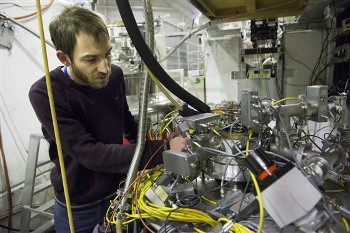Mar 29 2013
In today's Physical Review Letters, the Antihydrogen TRAP (ATRAP) experiment at CERN's Antiproton Decelerator (AD) reports a new measurement of the antiprotonmagnetic moment made with an unprecedented uncertainty of 4.4 parts per million (ppm). This result is 680 times more precise than previous measurements.
 Stephan Ettenauer, a post-doctorial fellow on the ATRAP experiment , with the Penning trap apparatus for trapping antiprotons.
Stephan Ettenauer, a post-doctorial fellow on the ATRAP experiment , with the Penning trap apparatus for trapping antiprotons.
The unusual increase in precision is due to the experiment’s ability to By applying its single particle approach to the study of antiprotons, the ATRAP experiment has been able make precise measurements of the charge, mass and magnetic moment of the antiproton. Using a device called a Penning trap, a sort of electromagnetic cage, the antiproton is suspended at the centre of an iron ring electrode sandwiched between copper electrodes. Thermal contact with liquid helium keeps the electrodes at 4.2 K, providing a nearly perfect vacuum that eliminates the stray matter atoms that could otherwise annihilate the antiproton. Static and oscillating voltages applied to the electrodes allow the antiproton to be manipulated and its properties to be measured.
The ATRAP team found that the magnetic moments of the antiproton and proton are trap individual protons and antiprotons, and to using a huge magnetic gradient to gain sensitivity to the tiny magnetic moment. ATRAP’s new result is partly an attempt to understand the matter-antimatter imbalance of the universe, one of the great mysteries of modern physics.
“Precise comparisons of properties of antimatter and matter particles are intriguing and important, given that the fundamental cause of the dramatic imbalance of antimatter and matter in the universe has yet to be discovered,” explained ATRAP spokesperson Gerald Gabrielse of Harvard University. "By comparing the antiproton's tiny magnetic moment to that of the proton, we test the Standard Model and its CPT theorem at a high precision.”
"exactly opposite": equal in strength but opposite in direction with respect to the particle spins, consistent with the prediction of the Standard Model and its CPT theorem to 5 parts per million. However, the potential for much greater measurement precision puts ATRAP in position to eventually test the Standard Model prediction much more stringently.
“We plan to continue our investigation of CPT symmetry through further precision measurements of antiprotons,” said Gabrielse. "Combining the single particle methods with new quantum methods that make it possible to observe individual antiproton spin flips should make it feasible to compare an antiproton and proton to 1 part per billion or better.”
Physical Review Letters will next week publish a second report – the team's first observation of individual proton spin flips. Not content with the 680-fold more stringent test of the Standard Model and its CPT theorem reported today, ATRAP will use a proton to refine its new quantum methods to be ready to make increasingly precise tests when CERN resumes antiproton operations in 2014.